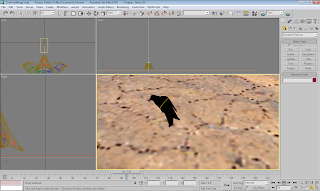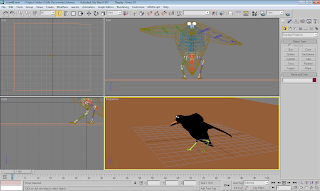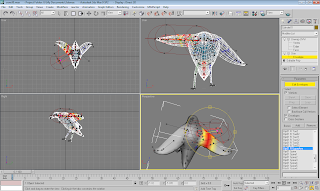Now that my animation is completed, I would say that it was a success. It presents Aesop's fable of the crow and the pitcher well, and isn't boring. The music really makes it come to life, and makes it enjoyable to watch. It kept true to it's cartoon style most of the way though as well.
The animation itself, I am quite proud of and the result was better than I thought possible at the start of the year. I am most please with the pebble-drop scene, the penultimate scene and the final scene. I am also pleased with the scene where the crow discovers the pitcher, as the camera motion is different from the rest.
I would have liked to use morpher to animate facial expressions, but as there is very little a crow can do, and there is no lip syncing, it wasn't needed. Although I would have also liked to include voices, it wouldn't go with the style I was trying to achieve.
After rendering the last scene, I realised there was a mistake in the model itself, and that the tail wasn't capped. This wasn't obvious in the other scenes as the model was black and 2-side. However, it is visible for about half a second in the final few frames of the animation.
I think that the lighting I used worked well for the scene, although I would have liked to have used skylight more to make it seem brighter (The render time is much too long) . Increasing the intensity of the target light didn't have the same effect. Also, the transition is the end makes the point of "cooling" the scene.
The main problems I had with the creation of the model came from weighting the vertices. It became easier once I realised how weighting worked, and that each one had to add up to 1. I used mirror mode to complete the process in half the time it would have taken manually though. being able to move the bones successfully was a challenging task as well. However I found that if you move a bone, then fix the weights, the bone will be able to move freely without problems.
I am happy with my use of camera shots, I believe they convey each scene very well and are not completely static all the time. I have made use of the environment to maximise the effectiveness of each shot. From the footprint in the sand, to the reflection in the water, to the flight through the clouds.
If I were to change the project, I'd probably keep most of it. Although I'd fix the problems I've listed previously, maybe put more detail in the crow's texture and add a wider range of movements. I'd probably make it longer and add more scenes in between, including better scene transition.
Personally, I have enjoyed the assignment and feel like I have learnt a great deal about 3DS Max and 3D animation in general. However, it is probably not the primary area I wish to pursue after my studies are over. Although I may continue to use the program for model design and simple animations.




























.PNG)




















